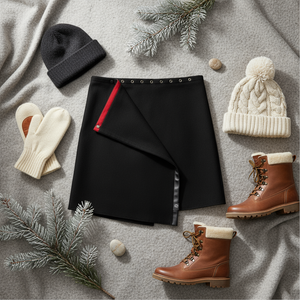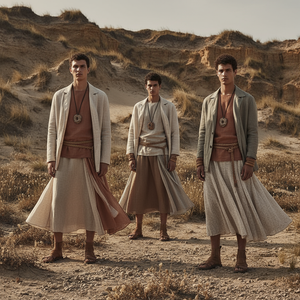Towards more eco-responsible fabric choices; Part I
Silhouette, mood and atmosphere are all translated through the language of fabric. In this article, we explore the life cycle of different fabrics, from plant to final product and beyond. The idea is to understand what an eco-friendly fabric is so that we can make better consumer choices that are good for our health, the environment and animals.
Here is a list of the main fabrics that are considered eco-friendly and also sustainable in the way they are grown and processed.
 The Flax:
The Flax:
One wonders why most of us don't know much about linen fabric, as it is a common textile. It was once so popular that even today, long after the cotton era and long before the era of artificial materials, all linen is often called "linen". It was once so valuable that it was used to wrap the bodies of mummies in Egypt, helping to preserve these ancient treasures.
Linen is a durable fabric made from linen fibers. The fiber is very strong, absorbent and dries faster than cotton due to its porous nature. Because of these characteristics, linen clothing is valued for its comfort in warm weather. Linen is grown in almost every country in the world and has been used to make fibers for over 6,000 years. To extract the fibers, the plants are either cut or pulled by hand from the ground (pulling is said to create a finer linen). The seeds are then removed in a process called winnowing or plucking, followed by retting which removes the plant material from the fibers. Once the fibers are separated to collect the longer pieces, which can be up to 20 centimeters long, they are then spun into yarn and finally woven into fabric.
Flax also has some drawbacks. As a fabric, it has little elasticity and can therefore wrinkle a lot. It is also more expensive than cotton. It's still a great choice for home decor accessories. https://www.thespruce.com/definition-of-linen-fabric-1976785
The hemp :
Hemp fabric is a sustainable textile made from the fibers of a very high-yielding crop of the cannabis sativa plant family. Historically used for industrial purposes, such as rope and sails, hemp is known as one of the most versatile and durable natural fibers. The plant has been recognized as a source of extraordinarily strong textile fibers for millennia, but the psychoactive qualities of Cannabis sativa have recently made it more difficult for farmers to produce this immensely beneficial crop. Only the outer layer of the Cannabis sativa stem is used for textile purposes. (sewport.com)
Hemp has 8 times the tensile strength of other natural fibers, making it the ideal choice for everyday use. Hemp fabric tends to be rough to the touch and is therefore often mixed with other fabrics such as cotton. Not only is hemp strong, but it also holds its shape, stretching less than any other natural fiber. ... Hemp is also naturally resistant to mildew and ultraviolet rays. (hemptraders.com) While a typical cotton T-shirt lasts up to 10 years, a hemp T-shirt can last double or triple that. Some estimates suggest that hemp fabric is three times more durable than cotton fabric. (sewport.com)
A landmark 1998 study is cited as an authority on the environmental sustainability of hemp fabric. Researchers noted that it requires less land to produce than cotton, and also releases fewer toxic substances into the soil and the broader ecosystem. Hemp is also considered a carbon-negative feedstock, meaning it absorbs more carbon than it produces. The production of this crop requires very few pesticides, and it does not require any herbicides. On the other hand, it has been indicated that hemp production may require more nitrogen than cotton cultivation.

The Silk:
For thousands of years, sericulture - the practice of growing, rearing and breeding silkworms - has remained a women's trade in Chinese culture. Although there are other types of silk rearing available for purchase, mulberry silk, the traditional type invented in China thousands of years ago, now accounts for about 90 percent of silk production. And while China still clings to the top spot, the second largest silk production market in the world is in India. There, silk is used to make a variety of garments and household items, including the beautiful formal saris worn by Indian women for special occasions such as weddings and parties.
Organic silk is a method of raising mulberry trees and silkworms without pesticides or additives that could harm humans or the environment. This method ensures that the yarn is naturally strong and safe for everyone.
Unfortunately, silk is not a vegan-friendly fabric. The process requires the silkworm to lose its life and not move on to the next phase of its life as a moth. In the natural cycle of life, in order to emerge from its cocoon, the silkworm must burn a hole through the large silk thread it has wrapped itself in. This damages the silk thread and makes it difficult to harvest hence the need to kill the silkworm before it emerges from the cocoon.
Silk is a very durable fabric, keeping the body cool in hot weather and warm in cold weather. It can last for decades in the closet. Silk-blend fabrics are very popular; and silk/linen and silk/organic cotton combinations are particularly wonderful, and all-natural too. At the end of its life, silk, as a natural material, is completely biodegradable, making this part of its life cycle a very sustainable choice. (eco-chick.com)
You wouldn't buy or use regular silk if you're vegan or against animal cruelty - because silkworms are usually boiled alive for processing.
However, silk is relatively sustainable and environmentally friendly (although the yield is quite low - it takes about 2500 silkworms to produce a pound of raw silk).
Compared to cotton, for example, its impact on the land, water and air is much less and it does not involve the use of pesticides.
Silk is very efficient in terms of inputs (land, water and resources needed at the growing stage).
Peace silk and other types of silk, such as art silk and spider silk, are other options to regular silk that are less cruel to animals or outright vegan.
The carbon footprint is very small.
There are energy inputs to grow the mulberry trees used to extract the mulberry leaves to feed the silkworm larvae.
The mulberry trees are actually a carbon sink, sequestering carbon from the atmosphere.
How much pesticide and fertilizer does silk use? Very little, only what is used to grow the mulberry trees.
Vegan alternatives to regular silk:
Peace silk, or Ahimsa silk - where silkworms are allowed to hatch naturally from their silk cocoons. This silk may have different capabilities, however, as the silk fibers are now shorter than if the egg was intact.
Spider silk - made from yeast, water and sugar.
Art silk - made from bamboo "silk" using a chemical process

Lyocell (Tencel) :
Lyocell is a biodegradable fiber made from eucalyptus trees. Eucalyptus, an extremely fast-growing resource, requires little water and virtually no pesticides to grow, making it a nice alternative to resource-intensive cotton.
Once the eucalyptus trees are harvested, primarily from sustainable farms, the wood is soaked in a non-toxic solution called amine oxide. Amine oxide is a petrochemical solution, but 99.5% is recovered, purified, and reused over and over again (Since the solvent is non-toxic, the small amount that is not reused is considered non-hazardous). The purpose of soaking the wood pulp in the solution is to extract the raw cellulose - a large part of the cell wall (remember high school biology? That's the part of the cell that holds everything together. And it also happens to be the most common organic compound on Earth).
So water and wood go into the mill and fiber comes out.
Once the fiber is made, because it comes from trees, the textile itself is biodegradable.
The characteristics of Lyocell, beyond the manufacturing process, are also resource efficient. The fibers are pure white in color, with a soft, almost silky texture that does not need to be bleached. It is also very absorbent to dyes, so they spread faster and with a brighter color, so producers can use less dye and get more results for your dip.
The final product is breathable, durable, ideal for draping and wrinkle-free - yes, it's true! Designers often use the fabric for dresses, shirts, jeans or even bed sheets.
In 2000, the European Union awarded the Tencel manufacturing process an environmental prize in the "technology for sustainable development" category.
Bambou :
Bamboo is an extremely fast-growing grass (yes, it is technically a grass, although we use it as a wood), which takes only 4-5 years to mature and be harvested (compare to 20 years or more for other woods). It can grow up to one meter per day and grows back by its roots, which avoids the need to replant it (it is precisely this characteristic that makes it an invasive plant in some places). The growth of the plant puts little pressure on the environment as it requires no pesticides or irrigation to grow and can be harvested in a sustainable manner (Note: there have been reports of rainforests and other land being cleared to plant bamboo farms, which is obviously not sustainable).
The benefits of bamboo, which may (or may not, depending on the plantation of origin) apply to soils and building materials, do not apply to fabrics made from it.
Turning bamboo into a silky fabric is not possible without very intensive chemical processes, which use about 13 different toxic solvents. It is a viscose rayon process, which turns a cellulose fiber (plant material) into fabric. Any plant or tree - in this case bamboo - can be used as a source of cellulose, but the manufacturing process turns bamboo into rayon, and must be labeled as such.




